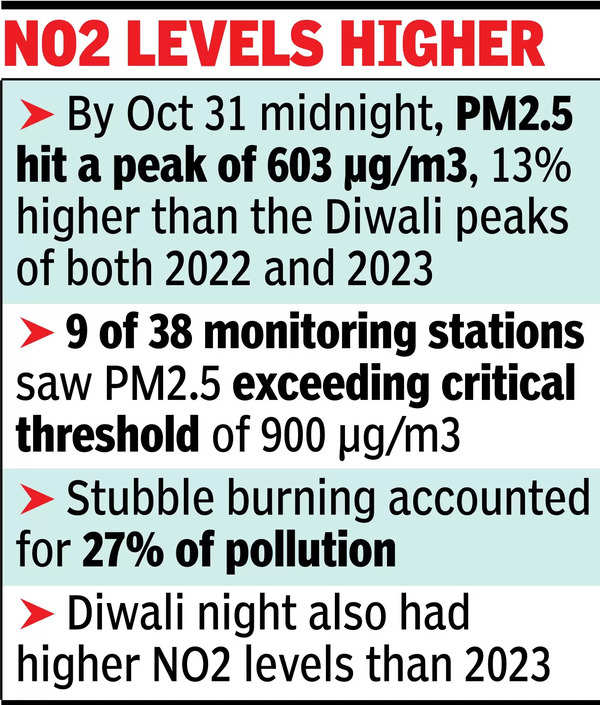NEW DELHI: An analysis by Centre for Science and Environment has drawn attention to the season’s first smog — on Diwali day. It also said that the PM2.5 concentration this Diwali was 34% higher than in 2022, despite both occurring in the month of October, reports Kushagra Dixit.
Diwali night this year also had higher nitrogen oxide levels than in 2023. In addition to the local cracker bursting, there was also a sharp rise in pollutants resulting from harvest stubble burning, accounting for 27% of the city’s pollutants that day. The analysis fo und that PM2.5 showed a spike of 46% from Oct 28 through to Oct 31, the festival day.
The study said that by midnight on Oct 31, PM2.5 hit a peak of 603 micrograms per cubic metre, 13% higher than Diwali peaks recorded in both 2022 (when Diwali occurred on Oct 24) and 2023 (Nov 12).
It established that PM2.5 in the pollution between 6am and 4pm on Diwali was 92% higher than last year, reflecting high local and regional pollution aided by the sharp increase in the share of farm pollutants.
However, the analysis noted that pollution dispersed quickly this year. “The reasons behind this late buildup and early dissipation of pollution on Diwali day were warm atmospheric conditions with relatively more efficient natural ventilation and adequate wind in the city,” the analysis explained.

CSE said there was a massive build-up of pollution in different parts of the city on Diwali night, reaching ‘severe’ levels. “This year, nine of the 38 air quality monitoring stations recorded PM2.5 concentrations exceeding the critical threshold of 900 micrograms per cubic metre on Diwali night,” the report said. “The highest levels were observed at Nehru Nagar, reaching 994 microgram per cubic metre, followed by Anand Vihar at 992, Pusa IMD at 985, Wazirpur at 980 and JLN Stadium at 963.”
The report noted the sudden escalation in farm fires on Diwali, which accounted for 27% of pollution in Delhi. “According to IARI data, the fire count increased from 60 on Oct 30 to 605 on Oct 31. Punjab ac counted for the highest share at 80%, followed by Uttar Pradesh at 13% and Haryana at 7%. North-westerly winds prevailed during the day on Oct 31, amplifying the impact of stubble burning on Delhi’s air quality,” the report said.
The city’s air quality turn ed from ‘poor’ to ‘very poor’ even when the share of smoke from farm fires was less than 3%, indicating the impact of local air pollution sources. As for vehicular pollution, the report stated that ITO had the highest NO2 levels.
“Diwali night this year had higher NO2 levels compared with last year’s Diwali night. NO2 levels in the last three years have been higher on Diwali night and also the nights preceding it, which is indicative of congestion and high traffic conditions in the city leading to the festival night. ITO had the highest NO2 levels in the city with a night-time average of 182 microgram per cubic metre. JLN Stadium and Patparganj, with 104 and 101 micrograms per cubic metre were the other NO2 hotspots on Diwali night. Lodhi Road, with just 2 microgram per cubic metre of NO2, was the least affected area in the city,” the report said, while warning that the upcoming cold and calm weather might intensify the pollution status.
